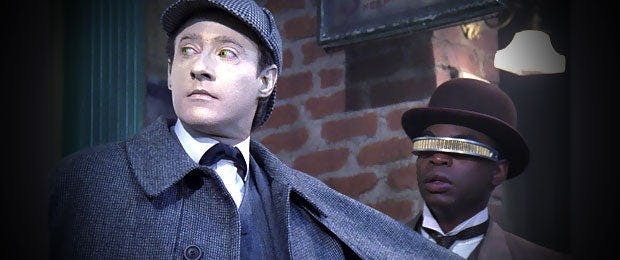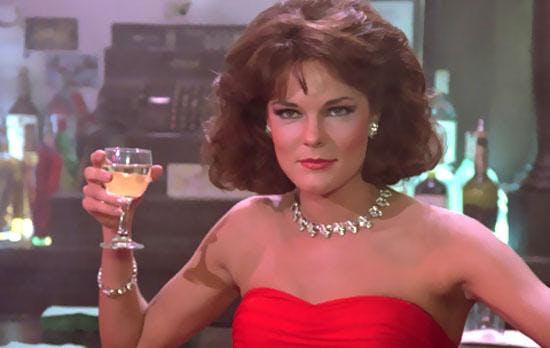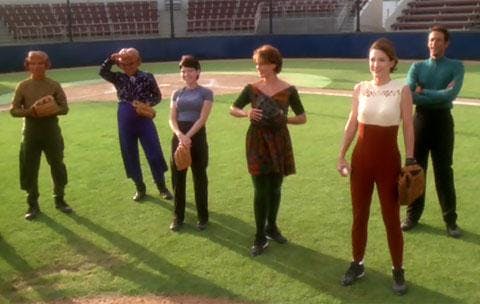Published Mar 11, 2014
Meet The Man Behind The Holodeck, Part 2
Meet The Man Behind The Holodeck, Part 2

Here’s a trivia question for you. Who put the idea of the holodeck into the mind of Star Trek creator, Gene Roddenberry? Here’s another one for you: Who invented the very first LCD projector? And one more: Who interacted in the ultimate fanboy video with DeForest Kelley, George Takei, Walter Koenig, James Doohan and Nichelle Nichols, which included an introduction by Roddenberry? The answers are one and the same -- Gene Dolgoff, whose bio proudly describes him as “an innovator and entrepreneur in electronics, optics, holography, lenticular, stereoscopic, and other forms of 3-D imaging, and displays, with over 65 granted patents worldwide and 40 patents pending.” Dolgoff, back in 1964, became one of the world's first holographers, for three years teaching a course in optics, lasers and holography at the City College of the City University of New York, and, not surprisingly, authoring the text and curriculum utilized in class.
These days, Dolgoff is Chairman, CEO and CTO of 3-D Vision, a Long Island-based company that conducts research to develop, license and market new products and technologies for the emerging 3D TV/computer field. Yet, for all that, Star Trek fans are most indebted to the man for his contribution to Star Trek, a contribution that’s universally accepted, but was never quite publicly acknowledged by Roddenberry. StarTrek.com caught up with Dolgoff at his office for an informative and science-centric conversation. Below is part two of our exclusive interview.
The holodeck ended up being a very cool sci-fi element, as well as a great storytelling device, on The Next Generation, Deep Space Nine and Voyager. Were you still in contact with Roddenberry when the holodeck turned up on TNG, because he’d passed away by the time DS9 and Voyager aired?
DOLGOFF: No. I think we’d lost contact by then.
So he never said, “We're using the holodeck on The Next Generation” or “Hey, did you see it. What did you think?”
DOLGOFF: That’s the way it goes, often; you come up with something and then you don’t get any recognition for it. I watched everything. I never missed an episode of any of the Star Trek franchises. I loved all the holodeck stuff. I thought it was really great and I really enjoyed it. I just wish I’d had more of an interaction (with the franchise). I was always wishing I’d be like the guy (Cochrane) they said invented the warp drive (and be mentioned or show up in a movie or episode).

But he did, in his own way, acknowledge your holodeck idea...
DOLGOFF: Let me tell you what he did do. He had me go to Universal Studios with my wife and allowed us to play guest captain and Vulcan science officer in a taped Star Trek rehearsal that, to my knowledge, has never aired in a TV show or a movie. But it is out there on the Internet (and now here on StarTrek.com). I felt honored that Gene allowed me to do that and felt that it was a gesture of appreciation for what I explained to him about holography. I'm not sure what year we did this, but I think it was 1989 or 1990.
OK, so, in layman’s terms, what is holography?
DOLGOFF: Holography is the recording and playback of a pattern of energy by recording the interference pattern of energy interacting with a reference beam. So, if you have an object and light is hitting that object, for instance, then the light will bounce off and that light has special information on it now that it picked up by hitting the object. There are only three kinds of information that it picks up. Each light ray has a specific angle, a specific brightness and a specific color. And that’s it. There’s also polarization, but that’s irrelevant because we don’t perceive polarization. Those three things, which I call the ABC’s of light – angle, brightness, color – are the only things that change when a light ray comes from the light source, let’s say, your ceiling light, and hits the object. The only thing that changes about the light is those three factors. So now they’ve bounced off of you and it’s the same light, but now they have different angles, brightnesses and colors.

If your eyes intercept that light, you see whatever it came from. So if I intercept that light, I see you. And if you interfere that light with a constant light beam, which is called a reference beam, it creates a pattern, an interference pattern, and that pattern can be recorded. Once that pattern is recorded it’s called a hologram, and the hologram now, if you shine that reference beam on it, with no information, the hologram itself will change those light rays and re-impart the proper angle, brightness and color, if done properly, to each ray. So now, if the same light information is coming towards you, you’ll look at it and you’ll still see the same thing. Now that’s a hologram for recording and playback.
Which ultimately leads to the interference pattern…
DOLGOFF: Now, I just described it using light, but if you use the kind of energy that’s higher in frequency, so that it can interact with the smaller features of matter, like gamma rays, you get the interference pattern – which again is the angle, brightness and, instead of color, frequency – of the rays that are coming from the small structure of the atoms, you record that pattern, you play back the same information, the same angle, brightness and color values of those small waves and, if you create what’s called a real image, it can reconstruct the object itself. So if you have a bunch of guests for dinner and you’re short a chair, you take out a hologram of the chair, it reconstructs another chair, and now that guest can sit on that chair because it’s got physical form. If you need food… this is how the replicator works on Star Trek. You have a hologram of an apple. So now the hologram reconstructs an apple. It’s just from energy, but once you eat the apple it has a taste and the texture and the nutritional value of an apple. So it’s basically all the same technology that applies to the replicator, transporter and holodeck.
While we digest that, give us a sense of what you’re up to these days…

DOLGOFF: I work on quite a lot of different technologies. All of the projectors in the world are based on my original invention (of digital projection) and patents. All the movie theaters, for instance, use digital projectors. So I’m actively involved in trying to collect royalties from that. I did the holograms on (credit and debit) cards; I invented the method of printing them. I have another breakthrough, which is full-color holography that is inexpensively printable. And, even though I invented that in 1971, I have never disclosed it or patented it. So I’m sitting on it, and that’s because there’s no point in putting a patent out or even paying for a patent if the market is not there, because the patent life is only 20 years and the time will come and go and it’ll expire, and nothing will have happened if you don’t time it right. So I’m sitting on that.
But now what I’ve developed is the next level of 3D TV, and that is 3D without glasses, using the holographic projection technology. So I’m writing a patent on that right now. We already have a prototype that works, but once that (patent) is done we’re going to try to find relationships with proper companies, get funding, get products made, and this will be the next step in 3D entertainment, advertising and medical imaging. It’ll be projecting images in midair that you can pass your hand through, and you don’t need any glasses, and unlike the stereoscopic technology in movie theaters and on TV today, there will be not only no glasses, but no eye strain. That’s the next step that we’re doing and then, in another decade or so, will be the true, full holographic projection, which will then become room-size and surround you. And, essentially, it will be the first step towards Star Trek’s holodeck. Wouldn't it be great to see something like that as a story thread in one of the new Star Trek movies?
Don't forget to read Part One of our interview with Gene Dolgoff.

